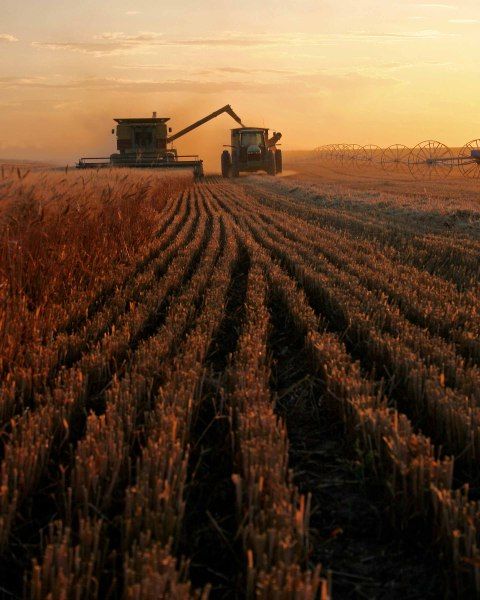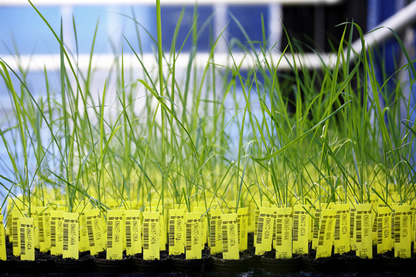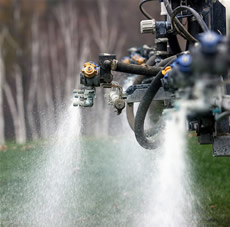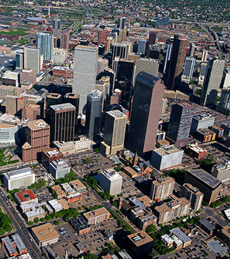Agriculture
Many current problems in agriculture are not new. Erosion and pollution, for example, have been around as long as agriculture. However, agriculture has changed drastically within its ten-thousand-year history, especially since the dawn of the Industrial Revolution in the seventeenth century.
Erosion and pollution are now bigger problems than before and have been joined by a host of other issues that are equally critical?not all related to physical deterioration.
Monoculture
Modern agriculture emphasizes crop specialization, also known as monoculture. Farmers, especially in industrialized regions, often grow a single crop on much of their land. Problems associated with this practice are exacerbated when a single variety or cultivar of a species is grown. Such a strategy allows the farmer to reduce costs, but it also makes the crop, and thus the farmand community, susceptible to widespread crop failure.
The corn blight of 1970 devastated more than 15 percent of the North American corn crop. The cornwas particularly susceptible to the harmful organisms because 70 percent of the crop being grown was of the same high-yield variety. Chemical antidotes can fight pests, but they increase pollution.
Maintaining species diversity or varietal diversity?growing several different crops instead of one or two?allows for crop failures without jeopardizing the entire economy of a farm or region that specializes in a particular monoculture, such as tobacco, coffee, or bananas.
Genetic Engineering
Growing genetically modified (GM) crops is one attempt to replace post-infestation chemical treatments. Recombinant technologies used to splice genes into varieties of rice or potatoes from other organisms are becoming increasingly common. The benefits of such GM crops include more pest-resistant plants and higher crop yields.
However, environmentalists fear new genes could trigger unknown side effects with more serious, long-term environmental and economic consequences than the problems they were used to solve. GM plants designed to resist herbicide applications could potentially pass the resistant gene to closely related wild weed species that would then become "super weeds".
Also, pests, just as they can develop resistance to pesticides, may also become resistant to defenses engineered into GM plants. The high cost of recombinant technologies calls into question the feasibility of continuing development of GM plants.
Erosion
An age-old problem, soil loss from erosion occurs all over the world.As soil becomes unproductive or erodes away, more land is plowed. The newly plowed lands usually are considered marginal, meaning they are too steep, nonporous or too sandy, or deficient in some other way.
When natural vegetative cover blankets these soils, it protects them from erosive agents: water, wind, ice, or gravity. Plant cover "catches" rainwater that seeps downward into the soil rather than running off into rivers. As marginal land is plowed or cleared to grow crops, erosion increases.
Expansion of land under cultivation is not the only factor contributing to erosion. Fragile grasslands in dry areas also are being used more intensively. Grazing more livestock than these pastures can handle decreases the amount of grass in the pasture and exposes more of the soil to wind, the primary erosive agent in dry regions.
Overgrazing can affect pastureland in tropical regions too. Thousands of acres of tropical forest have been cleared to establish cattle-grazing ranges in Latin America. Tropical soils, although thick, are not very fertile. After one or two growing seasons, crops grown in these soils will yield substantially less than before.
Tropical fields require fallow periods of about ten years to restore the soil after it is depleted. That is why tropical farmers using slash-and-burn agriculture move to new fields every few years in a cycle that returns them to the same place years later, after their particular lands have regenerated.
Where there is heavy forest cover, soils are protected from exposure to the massive amounts of rainfall. Organic material for crops is present as long as the forest remains in place.
When the forest is cleared, however, the resulting grassland cannot provide the adequate protection, and erosion accelerates. Lands that are heavily grazed provide even less protection from heavy rains, and erosion accelerates even more.
The use of machines also promotes erosion, and modern agriculture relies on machinery such as tractors, harvesters, trucks, balers, and ditchers. In industrialized nations, machinery is used intensely. Machinery use is on the rise in developing countries such as India, China, Mexico, and Indonesia, where traditional, nonmechanized farming methods are the norm.
Farming machines, in gaining traction, loosen topsoil and inhibit vegetative cover growth, especially when farm implements designed to rid the soil of weeds are attached. The soil is then more prone to erode.
Eco-fallow farming has become more popular in the United States and Europe as a way to reduce erosion. This method of agriculture, which leaves the crop residue in place over the fallow (non-growing) season, does not root the soil in place as well as living plants do.
As a result, some erosion continues. Additionally, eco-fallow methods require heavy use of chemicals, such as herbicides, to "burn down" weed growth at the start of the growing season. This contributes to increased erosion and pollution.
Pollution and Silt
Besides causing resistance among harmful bacteria, insects, and weeds, pesticides inevitably wash into, and contaminate, surface and groundwater supplies. Chemicals, although problematic, are not as difficult to contend with as the increasingly heavy silt load choking the life out of streams and rivers.
Accelerated erosion from water runoff carries silt particles into streams, where they remain suspended and inhibit the growth of many forms of plant and animal life.
The silt load inAmerican streams has become so heavy that the Mississippi River Delta is growing faster than it once did. Heavy silt loads, combined with chemical residues, are creating an expanded dead zone. By taxing the capabilities of ecosystems around the Delta, sediments are filtered out slowly, plant absorption of nutrients is decreased, and salinity levels for aquatic life cannot be stabilized.
Most of the world?s population lives in coastal zones, and 80 percent of the world?s fish catch comes from coastal waters over continental shelves that are most susceptible to this form of pollution.
Pesticide Resistance
With the onset of the Green Revolution, the use of herbicides, insecticides, and other pesticides increased dramatically all over the world. An increasing awareness of problems caused by overuse of pesticides extends even to household antibacterial cleaning agents and other products. Mutations among the genes of bacteria and plants have allowed these organisms to resist the effects of chemicals that were toxic to their ancestors.
Use of pesticides leads to a cycle wherein more, or different combinations of, chemicals are used, and more pests develop resistance to these toxins. Additionally, the development of herbicide-resistant crop plants enables greater use of herbicides to kill undesirable weeds on croplands.
Increasing interest in biopesticides may slow the cycle of pesticide resistance. Types of biopesticides include beneficial microbes, fungi, and insects such as ladybugs that can be released in infested areas to prey upon specific pests. Biopesticides used today include naturally occurring and genetically modified organisms. Their use also avoids excessive reliance on chemical pesticides.
Fertilizers and Eutrophication
Increased use of fertilizers was another result of the Green Revolution. Particulate amounts of most fertilizers enter the hydrologic cycle through run-off. As a result, bodies of water become enriched in dissolved nutrients, such as nitrates and phosphates.
The growth of aquatic plants in rivers and lakes is overstimulated, and this results in the depletion of dissolved oxygen. This process of eutrophication can harm all aquatic life in these ecosystems.
Water Depletion
With an increasing reliance on irrigation, groundwater resources are mismanaged and overtapped. The rate of groundwater recharge is slow, usually between 0.1 and 0.3 percent per year. When the amount of water pumped out of the ground exceeds the recharge rate, it is referred to as aquifer overdraft. An aquifer is a water-bearing stratum of permeable rock, sand, or gravel.
In Tamil Nadu, India, groundwater levels dropped 25 to 30 meters during the 1970?s due to excessive pumping for irrigation. In Tianjin, China, the groundwater level declines 4.4 meters per year. In the United States, aquifer overdraft averages 25 percent over the replacement rate.
The Ogallala aquifer under Kansas, Nebraska, and Texas represents an extreme example of overdraft: Depletion is 130 to 160 percent above the replacement rate annually. At this rate, this aquifer, which supplies water to countless communities and farms, has been projected to become nonproductive by 2030.
Soil Salinization
In addition, continued irrigation of arid regions can lead to soil problems. Soil salinization is widespread in the small-grained soils of these regions, which have a high water absorption capacity and a low infiltration rate.
Some irrigation practices add large amounts of salts into the soil, increasing its natural rate of salinization. This can also occur at the base of a hill slope. Soil salinization has been recognized as a major process of land degradation.
Although surface and groundwater resources cannot be enriched by technology, conservation and improved environmental management can make the use of precious freshwater more efficient. In agriculture, for example, drip irrigation can reduce water use by nearly 50 percent. In developing countries, though, equipment and installation costs often limit the availability of these more efficient technologies.
Urban Sprawl
As more farms become mechanized, the need for farmers and farm workers is being drastically reduced. From a peak in 1935 of about 6.8 million farmers farming 1.1 billion acres, the United States at the end of the twentieth century counted fewer than 2 million farmers farming 950 million acres.
Urban sprawl converts a tremendous amount of cropland into parking lots, malls, industrial parks, and suburban neighborhoods. If cities were located in marginal areas, then concern about the loss of farmland to commercial development would be nominal.
However, the cities attracting the greatest numbers of people have too often replaced the best cropland. Taking the best cropland out of primary production imposes a severe economic penalty.
- The Benefits Of Agricultural
Agricultural biotechnology is any technique in Which living organisms, or parts of organisms are altered to make or modify agricultural products, to improve crops, or develop microbes for specific uses in agricultural processes. Simply put, when the...
- Nutrient Pollution
Nutrient pollution refers to a form of pollution in which nutrients, usually nitrogen and phosphorus, which are present in high concentrations is harmful to the ecosystem. Nutrient pollution is primarily a problem in aquatic ecosystems such as streams,...
- Farmland
FarmlandLand used as farmland typically has good agricultural soil and is able to produce food and fiber in an efficient way. Land suitable for agriculture is not evenly distributed throughout the world; it tends to be concentrated in limited areas. In...
- Irrigation
IrrigationIrrigation techniques supply additional water to arid and semiarid horticulture or farming regions where few, if any, crops could otherwise be grown. Approximately 350 million acres (142 million hectares) of land worldwide are irrigated. In...
- Soil Degradation
Soil DegradationA decline in soil quality, productivity, and usefulness due to natural causes, human activities, or both, is known as soil degradation. It is often caused by unfavorable alterations in one or all of a soil?s physical, chemical, and biological...
Agriculture
Modern Agriculture Problems
 |
| Modern Agriculture |
Many current problems in agriculture are not new. Erosion and pollution, for example, have been around as long as agriculture. However, agriculture has changed drastically within its ten-thousand-year history, especially since the dawn of the Industrial Revolution in the seventeenth century.
Erosion and pollution are now bigger problems than before and have been joined by a host of other issues that are equally critical?not all related to physical deterioration.
Monoculture
Modern agriculture emphasizes crop specialization, also known as monoculture. Farmers, especially in industrialized regions, often grow a single crop on much of their land. Problems associated with this practice are exacerbated when a single variety or cultivar of a species is grown. Such a strategy allows the farmer to reduce costs, but it also makes the crop, and thus the farmand community, susceptible to widespread crop failure.
  |   |
The corn blight of 1970 devastated more than 15 percent of the North American corn crop. The cornwas particularly susceptible to the harmful organisms because 70 percent of the crop being grown was of the same high-yield variety. Chemical antidotes can fight pests, but they increase pollution.
Maintaining species diversity or varietal diversity?growing several different crops instead of one or two?allows for crop failures without jeopardizing the entire economy of a farm or region that specializes in a particular monoculture, such as tobacco, coffee, or bananas.
Genetic Engineering
Growing genetically modified (GM) crops is one attempt to replace post-infestation chemical treatments. Recombinant technologies used to splice genes into varieties of rice or potatoes from other organisms are becoming increasingly common. The benefits of such GM crops include more pest-resistant plants and higher crop yields.
 |
| Genetic Engineering |
However, environmentalists fear new genes could trigger unknown side effects with more serious, long-term environmental and economic consequences than the problems they were used to solve. GM plants designed to resist herbicide applications could potentially pass the resistant gene to closely related wild weed species that would then become "super weeds".
Also, pests, just as they can develop resistance to pesticides, may also become resistant to defenses engineered into GM plants. The high cost of recombinant technologies calls into question the feasibility of continuing development of GM plants.
Erosion
 |
| Erosion |
When natural vegetative cover blankets these soils, it protects them from erosive agents: water, wind, ice, or gravity. Plant cover "catches" rainwater that seeps downward into the soil rather than running off into rivers. As marginal land is plowed or cleared to grow crops, erosion increases.
Expansion of land under cultivation is not the only factor contributing to erosion. Fragile grasslands in dry areas also are being used more intensively. Grazing more livestock than these pastures can handle decreases the amount of grass in the pasture and exposes more of the soil to wind, the primary erosive agent in dry regions.
Overgrazing can affect pastureland in tropical regions too. Thousands of acres of tropical forest have been cleared to establish cattle-grazing ranges in Latin America. Tropical soils, although thick, are not very fertile. After one or two growing seasons, crops grown in these soils will yield substantially less than before.
Tropical fields require fallow periods of about ten years to restore the soil after it is depleted. That is why tropical farmers using slash-and-burn agriculture move to new fields every few years in a cycle that returns them to the same place years later, after their particular lands have regenerated.
Where there is heavy forest cover, soils are protected from exposure to the massive amounts of rainfall. Organic material for crops is present as long as the forest remains in place.
When the forest is cleared, however, the resulting grassland cannot provide the adequate protection, and erosion accelerates. Lands that are heavily grazed provide even less protection from heavy rains, and erosion accelerates even more.
The use of machines also promotes erosion, and modern agriculture relies on machinery such as tractors, harvesters, trucks, balers, and ditchers. In industrialized nations, machinery is used intensely. Machinery use is on the rise in developing countries such as India, China, Mexico, and Indonesia, where traditional, nonmechanized farming methods are the norm.
Farming machines, in gaining traction, loosen topsoil and inhibit vegetative cover growth, especially when farm implements designed to rid the soil of weeds are attached. The soil is then more prone to erode.
Eco-fallow farming has become more popular in the United States and Europe as a way to reduce erosion. This method of agriculture, which leaves the crop residue in place over the fallow (non-growing) season, does not root the soil in place as well as living plants do.
As a result, some erosion continues. Additionally, eco-fallow methods require heavy use of chemicals, such as herbicides, to "burn down" weed growth at the start of the growing season. This contributes to increased erosion and pollution.
Pollution and Silt
Besides causing resistance among harmful bacteria, insects, and weeds, pesticides inevitably wash into, and contaminate, surface and groundwater supplies. Chemicals, although problematic, are not as difficult to contend with as the increasingly heavy silt load choking the life out of streams and rivers.
Accelerated erosion from water runoff carries silt particles into streams, where they remain suspended and inhibit the growth of many forms of plant and animal life.
The silt load inAmerican streams has become so heavy that the Mississippi River Delta is growing faster than it once did. Heavy silt loads, combined with chemical residues, are creating an expanded dead zone. By taxing the capabilities of ecosystems around the Delta, sediments are filtered out slowly, plant absorption of nutrients is decreased, and salinity levels for aquatic life cannot be stabilized.
Most of the world?s population lives in coastal zones, and 80 percent of the world?s fish catch comes from coastal waters over continental shelves that are most susceptible to this form of pollution.
Pesticide Resistance
 |
| Pesticide Resistance |
Use of pesticides leads to a cycle wherein more, or different combinations of, chemicals are used, and more pests develop resistance to these toxins. Additionally, the development of herbicide-resistant crop plants enables greater use of herbicides to kill undesirable weeds on croplands.
Increasing interest in biopesticides may slow the cycle of pesticide resistance. Types of biopesticides include beneficial microbes, fungi, and insects such as ladybugs that can be released in infested areas to prey upon specific pests. Biopesticides used today include naturally occurring and genetically modified organisms. Their use also avoids excessive reliance on chemical pesticides.
Fertilizers and Eutrophication
Increased use of fertilizers was another result of the Green Revolution. Particulate amounts of most fertilizers enter the hydrologic cycle through run-off. As a result, bodies of water become enriched in dissolved nutrients, such as nitrates and phosphates.
The growth of aquatic plants in rivers and lakes is overstimulated, and this results in the depletion of dissolved oxygen. This process of eutrophication can harm all aquatic life in these ecosystems.
Water Depletion
With an increasing reliance on irrigation, groundwater resources are mismanaged and overtapped. The rate of groundwater recharge is slow, usually between 0.1 and 0.3 percent per year. When the amount of water pumped out of the ground exceeds the recharge rate, it is referred to as aquifer overdraft. An aquifer is a water-bearing stratum of permeable rock, sand, or gravel.
In Tamil Nadu, India, groundwater levels dropped 25 to 30 meters during the 1970?s due to excessive pumping for irrigation. In Tianjin, China, the groundwater level declines 4.4 meters per year. In the United States, aquifer overdraft averages 25 percent over the replacement rate.
The Ogallala aquifer under Kansas, Nebraska, and Texas represents an extreme example of overdraft: Depletion is 130 to 160 percent above the replacement rate annually. At this rate, this aquifer, which supplies water to countless communities and farms, has been projected to become nonproductive by 2030.
Soil Salinization
In addition, continued irrigation of arid regions can lead to soil problems. Soil salinization is widespread in the small-grained soils of these regions, which have a high water absorption capacity and a low infiltration rate.
Some irrigation practices add large amounts of salts into the soil, increasing its natural rate of salinization. This can also occur at the base of a hill slope. Soil salinization has been recognized as a major process of land degradation.
Although surface and groundwater resources cannot be enriched by technology, conservation and improved environmental management can make the use of precious freshwater more efficient. In agriculture, for example, drip irrigation can reduce water use by nearly 50 percent. In developing countries, though, equipment and installation costs often limit the availability of these more efficient technologies.
Urban Sprawl
 |
| Urban Sprawl |
Urban sprawl converts a tremendous amount of cropland into parking lots, malls, industrial parks, and suburban neighborhoods. If cities were located in marginal areas, then concern about the loss of farmland to commercial development would be nominal.
However, the cities attracting the greatest numbers of people have too often replaced the best cropland. Taking the best cropland out of primary production imposes a severe economic penalty.
- The Benefits Of Agricultural
Agricultural biotechnology is any technique in Which living organisms, or parts of organisms are altered to make or modify agricultural products, to improve crops, or develop microbes for specific uses in agricultural processes. Simply put, when the...
- Nutrient Pollution
Nutrient pollution refers to a form of pollution in which nutrients, usually nitrogen and phosphorus, which are present in high concentrations is harmful to the ecosystem. Nutrient pollution is primarily a problem in aquatic ecosystems such as streams,...
- Farmland
FarmlandLand used as farmland typically has good agricultural soil and is able to produce food and fiber in an efficient way. Land suitable for agriculture is not evenly distributed throughout the world; it tends to be concentrated in limited areas. In...
- Irrigation
IrrigationIrrigation techniques supply additional water to arid and semiarid horticulture or farming regions where few, if any, crops could otherwise be grown. Approximately 350 million acres (142 million hectares) of land worldwide are irrigated. In...
- Soil Degradation
Soil DegradationA decline in soil quality, productivity, and usefulness due to natural causes, human activities, or both, is known as soil degradation. It is often caused by unfavorable alterations in one or all of a soil?s physical, chemical, and biological...
